

Story and Photography
by
W. RAY SCOTT
Published by
NATIONAL PARK CONCESSIONS, INC.
Copyrighted 1950 by National Park Concessions, Inc.
| National Parks | |
|---|---|
| ACADIA | MAINE |
| BIG BEND | TEXAS |
| BRYCE CANYON | UTAH |
| CARLSBAD CAVERNS | NEW MEXICO |
| CRATER LAKE | OREGON |
| EVERGLADES | FLORIDA |
| GLACIER | MONTANA |
| GRAND CANYON | ARIZONA |
| GRAND TETON | WYOMING |
| GREAT SMOKY MOUNTAINS | NORTH CAROLINA & TENNESSEE |
| HAWAII | HAWAII |
| HOT SPRINGS | ARKANSAS |
| ISLE ROYALE | MICHIGAN |
| KINGS CANYON | CALIFORNIA |
| LASSEN VOLCANIC | CALIFORNIA |
| MAMMOTH CAVE | KENTUCKY |
| MESA VERDE | COLORADO |
| MOUNT McKINLEY | ALASKA |
| MOUNT RAINIER | WASHINGTON |
| OLYMPIC | WASHINGTON |
| PLATT | OKLAHOMA |
| ROCKY MOUNTAIN | COLORADO |
| SEQUOIA | CALIFORNIA |
| SHENANDOAH | VIRGINIA |
| VIRGIN ISLANDS | VIRGIN ISLANDS |
| WIND CAVE | SOUTH DAKOTA |
| YELLOWSTONE | WYOMING-MONTANA-IDAHO |
| YOSEMITE | CALIFORNIA |
| ZION | UTAH |

Southwestern Texas, along the Big Bend of the Rio Grande, one of the last scenic frontiers of America is located in a remote and unspoiled setting. Vast stretches of plains and range land, interspersed with numerous outcroppings of buttresses and ridges, end abruptly against a mass of mountains near the Mexican border. Etched and carved by the master hand of “Erosion” giant arroyos and imposing gorges are spread through the area in wild abandon. Towering, jagged peaks of the Chisos Mountains merge with the desert, plains and valleys in Big Bend National Park to create a kaleidoscopic pattern of dramatic contrasts and striking grandeur.
The northern approach to Big Bend is through Marathon. Leaving U. S. Highway 90 from this point, the Park boundary at Persimmon Gap is about forty miles over State Road 51. The Big Bend area is about 330 miles west of San Antonio and 220 miles southeast of El Paso. Alpine, the western gateway to Big Bend is 118 miles from the Basin of the Chisos Mountains, in the center of the Park.
Embraced in the gigantic curve of the Rio Grande, the Park lies just across the river from Old Mexico, where many geological features have a profound influence on the scenic aspects of this area. On the east, majestically rising above the Boquillas Canyon, the Sierra del Carmen Range provides a picturesque backdrop for the mesquite and cactus covered plains. Two other canyons complete the international features on the south and west. At the southernmost boundary of the Park, and almost inaccessible, is the rugged Mariscal Canyon, where the Rio Grande has carved its tortuous channel through more than seven miles of limestone rock. Precipitous walls of this abyss are almost sixteen hundred and fifty feet in height. The most imposing and the most easily accessible of the three canyons is the Santa Elena, along the western boundary of Big Bend.
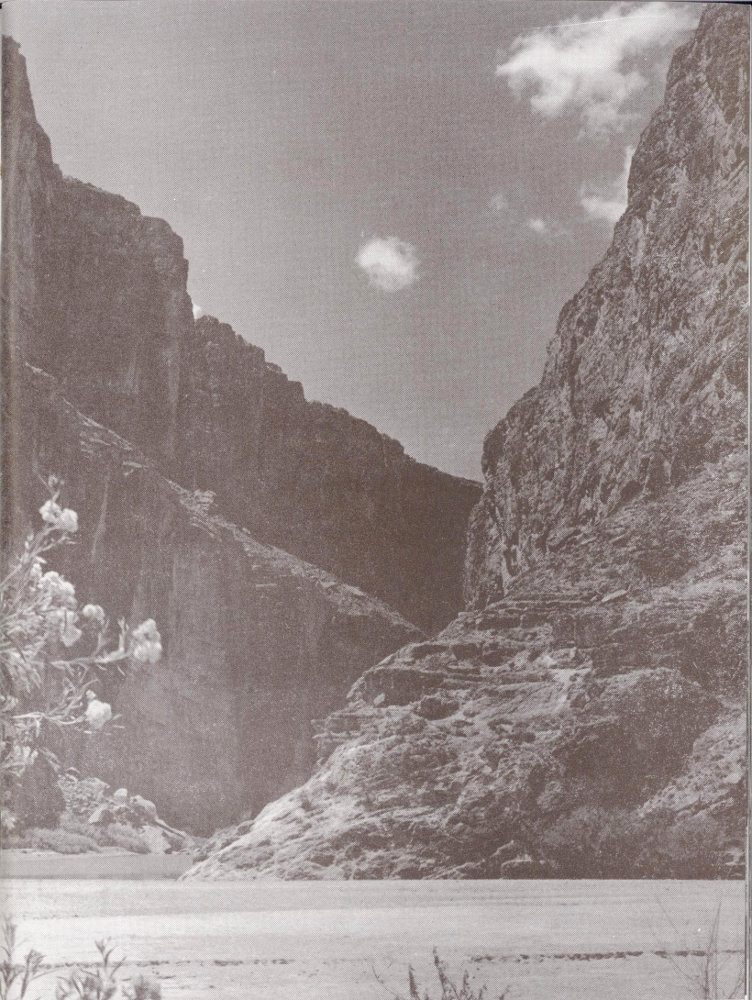
SANTA ELENA CANYON—The majestic grandeur of the Big Bend area is emphasized by the towering walls of the Santa Elena Canyon. Here, where the Rio Grande emerges from the winding gorge, Mexico appears at the left, the United States on the right.
Here, a deep gash in the mesa de Anguila and Sierra Ponce marks the course of the river for eighteen miles. Through millions of years, the silt and gravel laden waters have continued their endless task of grinding away the limestone bit by bit until now the walls of the canyon rise perpendicularly more than fifteen hundred feet above the waters of the river.

BOQUILLAS, MEXICO AND SIERRA DEL CARMEN RANGE—The Village of Boquillas is located in a picturesque setting along the Rio Grande and at the base of the Sierra del Carmen Range.
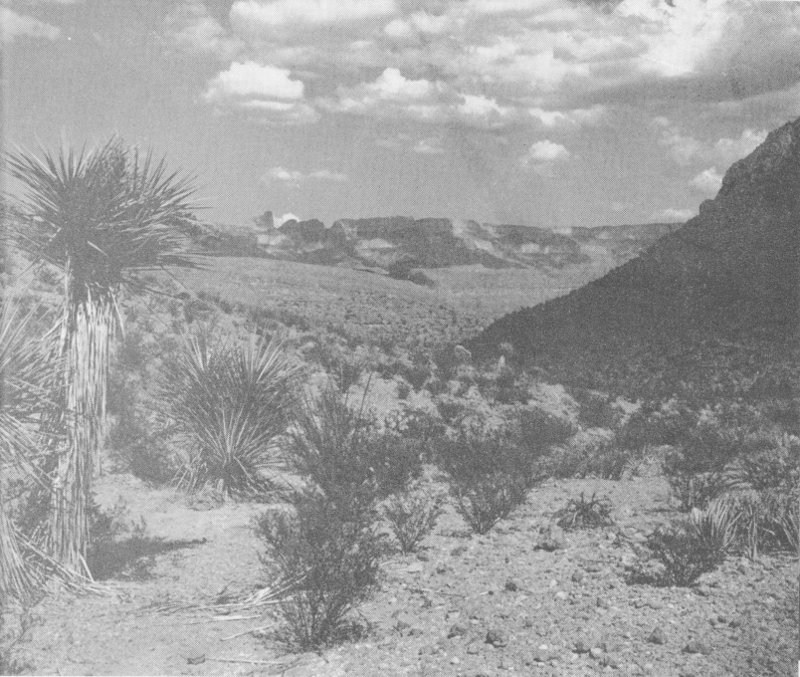
SIERRA DEL CARMEN RANGE—One of the outstanding scenic features of the eastern section of Big Bend National Park is Mexico’s picturesque Sierra del Carmen Range, which exceeds 8,000 feet in elevation.

SPIRES AND PINNACLES IN THE GRAPEVINE HILLS—Erosion, like a master sculptor, has carved many weird and grotesque forms throughout the Big Bend area.
The geological story of Big Bend is vividly revealed in the rock strata, the spires, buttresses, erosive remnants, arroyos and canyons. The entire Big Bend area was submerged by an ocean millions of years ago. Sediments of sand, mud and lime deposited on the floor of the sea later hardened into rock. Common to all oceans, various types of aquatic life abounded in these waters, many of which were fossilized in the forming of the rock. Igneous action within the earth’s interior caused an uplifting of the surface and receding of the ocean waters. It was during this period that giant trees grew and later became petrified. (Evidence may be noted on the Tornillo Flats.) Swamp and shoreline vegetation provided food for the dinosaurs during this period. As the igneous action increased, molten rock was deposited in some sections and mountains were 7 formed along the lines of greatest pressure. This newly formed rock was soft and highly susceptible to the processes of erosion, which gradually broke down the softer portions of the mountains, making deposits in the valleys and lowlands.
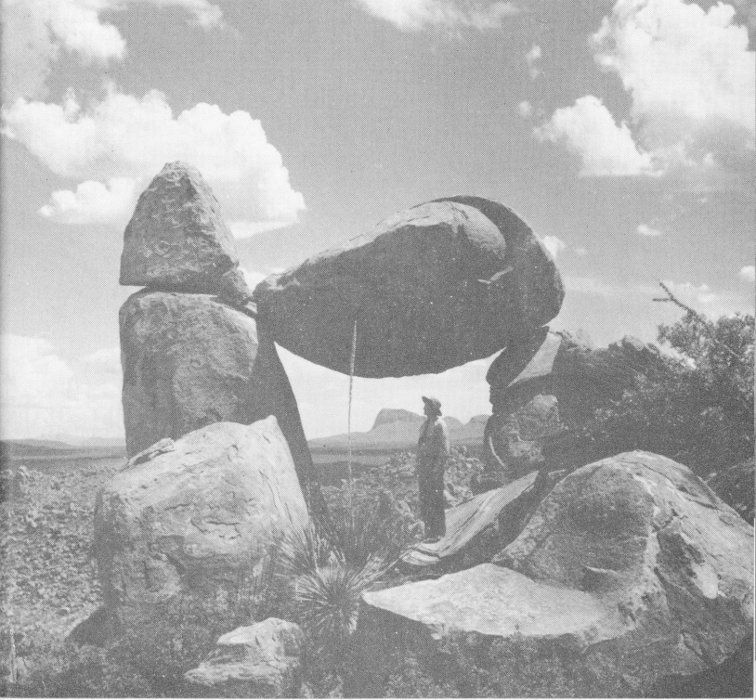
ROCK FORMATIONS IN THE GRAPEVINE HILLS—Fantastic shapes have been created by erosive action in the Big Bend National Park. Here, the massive boulders form a frame for the mountains in the distance.
Evidence of the tremendous force of erosion is very pronounced throughout the Big Bend National Park. Here nature has carved 8 a cross section out of the earth leaving the rocks of various geological eras etched in bold relief. The Big Bend country reveals to the novice a greater understanding of the geological evolution through which the earth has passed. Scientists, who have searched the arroyos, buttresses and canyons, have obtained vital information and substantiating facts which have contributed to the knowledge and advancement of the science of geology.
Climatic conditions throughout the Big Bend region are mild and arid. Here again, in this land of contrasts, it is possible to experience a variation of temperatures and weather conditions. During the hottest part of the summer the high altitudes of the Chisos Mountains remain moderate and cool, while the temperatures are much higher along the lower plains, the desert and river valleys. The annual rainfall is light, varying from 8 to 20 inches. Although there is some snow and freezing weather in the mountains during the winter months, extreme temperatures normally are of short duration. In other sections of the Park the temperatures rarely drop below freezing. Throughout the winter the temperatures are mild along the Rio Grande.

ARROYO—Arroyos dip below the plains in appalling vistas of sand and desert wasteland revealing the continuous processes of erosion. The foothills of the Chisos Mountains are in the distance.
Outstanding in natural phenomena the scenic features of Big Bend National Park comprise a variety of spectacular attractions. In addition to the canyons of the Rio Grande, numerous colorful arroyos dip below the plains in appalling vistas of sand, rock and scrub vegetation of the desert. Buttresses push their towering masses into the azure sky, revealing a graphic account of endless battles with the elements. The uncovered strata opens the book of geologic history. High in the Chisos Mountains, majestically reigning over the Basin, Casa Grande, an erosive remnant of rhyolite, rises 7,300 feet above sea level. This massive monolith is a conspicuous landmark, photogenic in its moods of shifting lights and shadows. Climaxing the mountain scenery are the outstanding vistas that unfold from the South Rim of the Chisos Mountains. From this lofty plateau, more than 7,000 feet above sea level and a mile above the sprawling valley of the Rio Grande, the extensive awe-inspiring view reaches far into Old Mexico. To the east, blue and purple in the distance, ranges of the Sierra del Carmen and Sierra Fronterisa pose in their grandeur. More than a hundred miles to the south the distant Sierra Madres form the horizon line in Mexico and the Mesa de Anguila forms a sharp outline to the west. Dropping sheer from the South Rim, precipitous cliffs slope into the Lower Chisos, more than 1,000 feet below the rim.

TULE MOUNTAIN—Erosion has carved innumerable spires and buttresses out of Big Bend’s igneous rock.

WEST FACE OF THE SOUTH RIM—Dynamic and spectacular, the view from the South Rim of the Chisos Mountains reaches across the Rio Grande and far into Old Mexico.
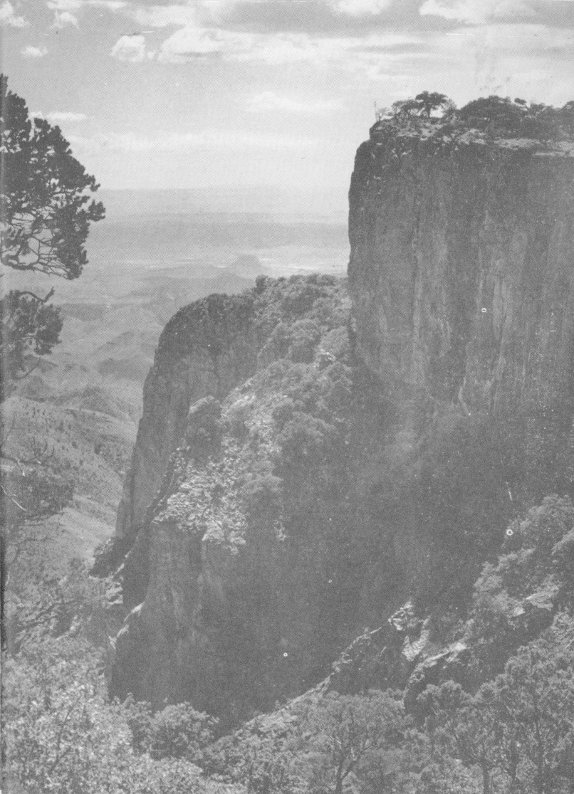
THE SOUTH RIM OF THE CHISOS MOUNTAINS—Looking west along the face of the South Rim where perpendicular cliffs drop more than 1,000 feet to the lower Chisos. The Rio Grande valley is in the middle distance.

SOUTH RIM VISTA—One of the most spectacular views in Big Bend National Park is the amazing expanse that unfolds from the South Rim of the Chisos Mountains. In the middle distance is the Rio Grande—and Mexico beyond.
Among the lesser peaks of the Chisos Mountains, many of the names are closely related to resemblance or legendary origin. Crown Mountain, Pummel Peak and Mule Ear Peaks are formed in the image of their namesakes. Legends of a lost silver mine center around Lost Mine Peak, supposed to be the scene of mining operations by the early Spanish explorers. Historical episodes of the 15 Spanish Conquistadors, legendary stories of the Apache Indians and the drama of bandits, rustlers and Texas rangers of the Wild West, have all made a definite contribution toward the fascination of the Big Bend country.
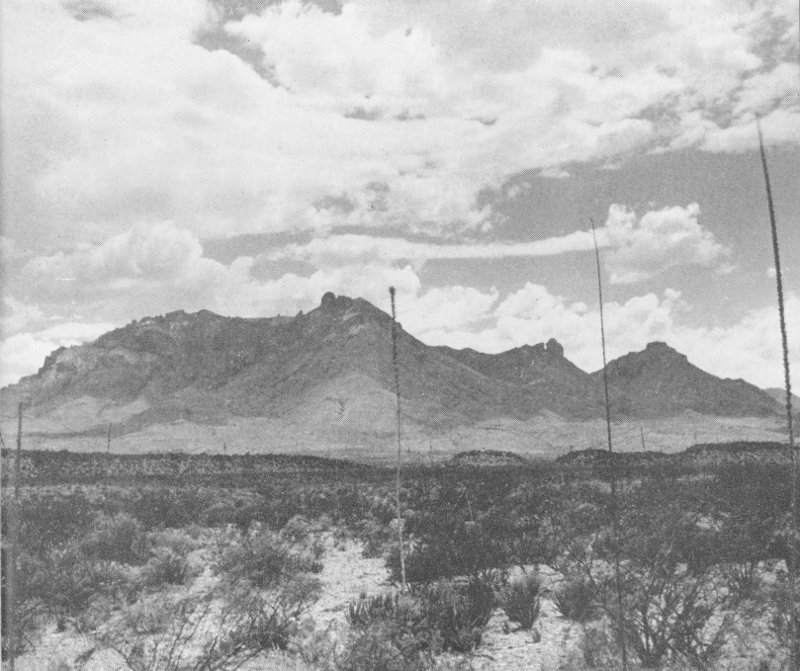
PUMMEL PEAK—From the plains, Pummel Peak in the Chisos Mountains, rises to form the replica of a massive saddle.

ANTELOPE—The natural habitat of the antelope is along the grassy slopes of Big Bend’s foothills, while mule deer roam the plains and the flag tail deer live in the higher elevations of the mountains.
The Chisos Mountains have been classed as a biological island due to their isolation from other mountain groups or ranges. While the Chisos are erroneously considered as the southern extremity of the Rocky Mountains they are widely separated by a vast expanse of desert and plains. This factor has influenced the types of wildlife that are prevalent in this area and many species are more closely related to the Sierra Madres in Mexico than to the environs of the Rockies. The flagtail deer, mountain lion and black bear are found at the higher elevations in the Chisos Mountains, while mule deer, antelope and javalina frequent the foothills and plains. Due to excessive hunting before Big Bend was established as a National Park, antelope and big horn sheep had completely disappeared 17 from the area. Antelope have been restocked in recent years and are gradually on the increase. Along the Rio Grande beaver and badger comprise the principal types of wildlife. Many rare species of birds found in Big Bend include the Colima warbler, aplomade falcon, Inca dove, white-necked raven and golden eagle. More common types are the orioles, tanagers, cardinals, hummingbirds, thrashers and wrens.

THE GOLDEN EAGLE—Rocky spires and crags in the high elevations of the Chisos Mountains provide an ideal setting for the Golden Eagle.
Vegetation in Big Bend National Park has been influenced by climatic conditions as well as the various elevations above sea level. These factors, contributing to species and types of plant communities, have provided for four separate groups—desert, foothills, mountains and river valley types. Many of the desert plants are typical of the vegetation of the desert and plains throughout the southwest. Some of the more common varieties include mesquite, petaya (or strawberry cactus), sotol, yucca, lechiguilla, prickly pear and cholla cactus. In the foothills and along the mountain slopes, 19 pinion and juniper trees as well as maguey and lesser plants, comprise the principal vegetation. Ponderosa pine and Douglas fir are the dominant types of forest trees found in the ravines and canyons of the higher mountains. Near the South Rim trees are sparse and many are dwarfed and twisted as a result of the continuous battle for survival. The trees and plants along the Rio Grande reflect the influence of moisture—cottonwoods, willows and cane reeds being common to this area.
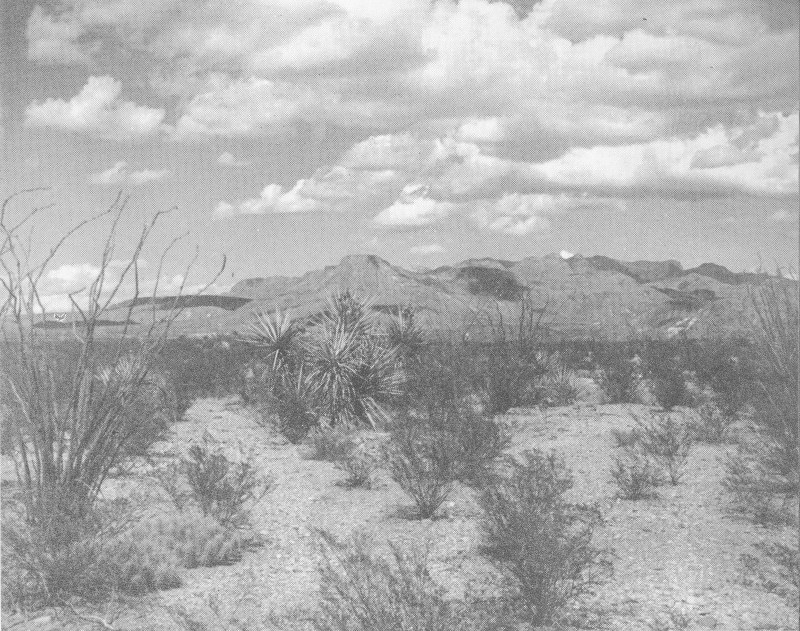
BIG BEND VEGETATION—Typical vegetation of the Big Bend area includes ocotillo, yucca, cactus, and mesquite.
The early history of the Big Bend country is linked with Indian legends and stories of the Spanish Conquistadors. In 1530 Cabeza de Vaca traveled through Big Bend during his expedition and exploration of the southwest. In his report on the area near the Rio Grande he mentioned the beans and melons that grew along the river valleys.

YUCCA OR SPANISH DAGGER—The yucca grows throughout the lower elevations of Big Bend National Park. During the spring blossoming season, the yucca exhibits a rare floral display in Dagger Flats.
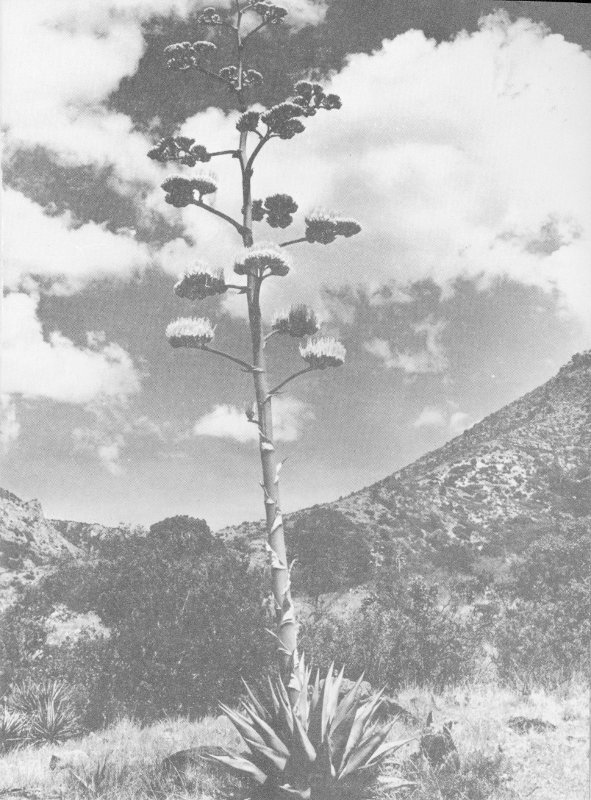
MAGUEY OR CENTURY PLANT—The golden yellow blossoms of the Century Plant make their appearance during late spring and early summer. This is one of the typical plants of the Big Bend area.

LOST MINE PEAK—As the road to the Basin winds up through Green Gulch, colorful peaks rise majestically on all sides. The summit of Lost Mine Peak, which is 7,000 feet in elevation, is reached by a trail from the Basin.
For many years Indians of the Apache and Comanche tribes lived and traveled through the Big Bend. They sought the seclusion and protection of the Chisos Mountains after raids in the United States and Mexico. The fighting Comanches of the Great Plains traveled through what is now a part of the National Park, enroute to Mexico where they raided and pillaged the ranches. The park entrance road now follows closely the route of the historic “Comanche Trail” through Big Bend.
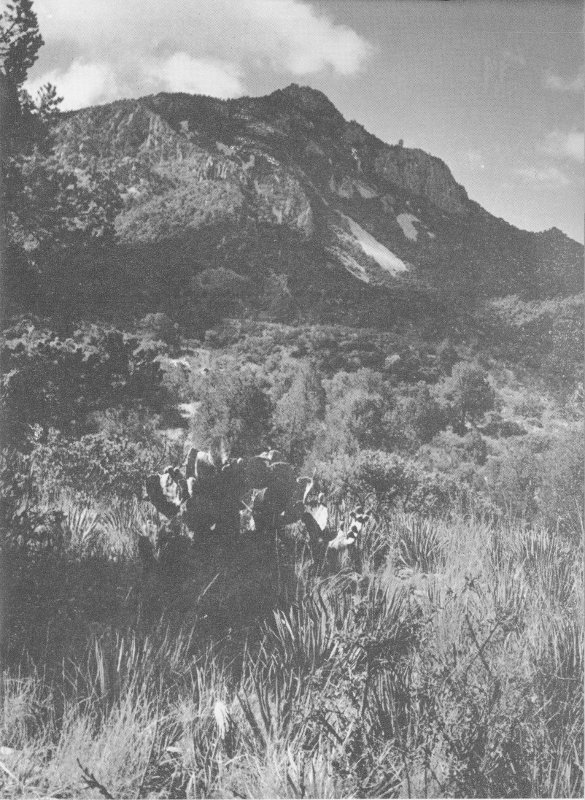
EMORY PEAK—With an elevation of 7,835 feet above sea level, Emory Peak is the highest mountain in Big Bend National Park. One of the dominating features of the Basin, Emory Peak was named for Major Emory.

THE WINDOW—From the Basin of the Chisos Mountains, the “Window” provides the only vista of the lower plains. Unique and colorful rock formations may be observed along the trail to the “Window.”

SANTA ELENA CANYON—The Rio Grande has carved its channel for eighteen miles through the Mesa de Anguila and Sierra Ponce. Here at the river’s exit, the walls of the canyon rise 1,500 feet above the Rio Grande.
Legendary stories of the Apache Indians and of lost silver mines are prevalent in the Big Bend region. A popular legend of Spanish and Mexican origin is related to Lost Mine Peak. More than one hundred years ago, when Texas was a part of Mexico, a prison was located at San Vincente, on the south side of the Rio Grande. On many occasions the prisoners were assigned to work in a mine located in the Chisos Mountains. None of the prisoners ever returned to San Vincente as those persons in command did not intend to divulge the location of the mine. To this day Mexicans like to 27 relate that on Easter Sunday morning, if a person will stand in the doorway of the San Vicente Mission and wait for the sun to rise, the first rays of the sun will strike a cave in the side of Lost Mine Peak, indicating the location of the mine. Many investigations and diligent searches for the mine have been unsuccessful, and Lost Mine Peak retains the secret of this legend in mute repose. Another phase of the lost mine story is that the miners were about to be attacked by a hostile band of Indians and blasted the opening of the mine, which was covered by an avalanche of igneous rock. The group of miners were pursued and killed by the Indians, carrying with them the secret of the mine’s location.
Following the early explorations of Cabeza de Vaca, the history of the Big Bend region is linked with Spanish Missionaries and the settlers and ranchers who began to push westward in the 1800’s. The Big Bend area was surveyed by Major W. H. Emory of the International Boundary Survey Commission of the United States and Mexico in 1852. Emory Peak, with an elevation of 7,835 feet, the highest in the Park, was named for Major Emory.
A later episode of historical significance is associated with the expedition of Lt. Echols in 1859-1860. Lt. Echols was sent from Fort Stockton to locate a site for an Army post in the Big Bend area, near the Comanche War Trail. During this expedition, in which camels were used to test their value in the desert southwest, Lt. Echols traveled along the Comanche Trail through an extensive section of the Park. In his report, which was published in Messages and Documents, Lt. Echols described his visit to the Santa Elena Canyon. He selected a site for a post near Castolon and reported favorably on the use of camels in the southwest.
After the Civil War settlers moved farther into the southwest and ranching became the principal industry throughout western Texas. The Southern Pacific Railroad, in keeping apace with this western movement, reached the present site of Alpine in 1882. Alpine was settled in 1883 and Marathon in 1886.

GREEN GULCH—Visitors entering the basin, follow the road up Green Gulch. Rock outcroppings include Casa Grande of upper left and erosive spires of Pulliam Mountain on the upper right.
Following this period, southwestern Texas passed through an era of cattle rustling, bandits and outlaws, with much of the activity centering around the Big Bend country. Texas rangers wrote vivid pages in this phase of Texas history, which was truly the “Wild West.” Graphic accounts of the daring and bravery which these men portrayed in establishing law and order has been dramatized in hundreds of stories and motion pictures.
The epic events of the “Old West” have contributed extensively to the popularity of the western cowboy, who might well be placed in the Hall of Fame with other American immortals.

THE CHISOS MOUNTAINS—At a distance of ten miles across the plains, the Chisos Mountains form a bold outline against the sky. This mountain group reaches an elevation of 7,835 feet above sea level.
The story of Big Bend’s development into a National Park reflects the interest and enthusiasm of the people of Texas. It was through the diligent effort and unselfish action of these people that this new Park has been set aside by the Congress of the United States for the preservation of its many natural features and the enjoyment of the people.
In 1933, through legislative action by the state of Texas, parts of the Big Bend area became Texas Canyons State Park. Later the same year another bill was passed which created Big Bend State Park.
Congressman R. E. Thomason in 1934 introduced a bill to establish a National Park in the Big Bend country. In 1935 Senator Morris Sheppard suggested in a letter to President Franklin D. Roosevelt, the establishment of an International Park along the Texas-Mexican border. A copy of this letter was sent to the Secretary 31 of the Interior for study and a report which was favorable to the International Park idea. The establishment of Big Bend National Park was authorized by Act of Congress June 20, 1935.

SPIRES OF PULLIAM MOUNTAIN—Spires and rock formations jut skyward, revealing unique patterns of light and shadows. Pulliam Mountain is one of the dominant features of the Basin.

THE BASIN FROM LOST MINE PEAK—A magnificent panorama of mountains and plains unfolds from Lost Mine Peak. At the upper left is Casa Grande and Bailey Mountain is at the upper-right center.
The Fort Worth Star-Telegram announced in July, 1937 a campaign to raise $1,000,000 by public subscription to purchase lands for the proposed Big Bend National Park. The next year, in May, 1938, Governor James V. Allred appointed an executive committee to work out plans for collecting $1,000,000 with which to acquire the lands for the Park. Later that year, when the Big Bend Park Association was organized, Amon G. Carter, of the Fort Worth Star-Telegram, was named President of the organization.
The Texas Legislature passed a bill in 1941 which provided for $1,500,000 to purchase lands for the Big Bend National Park. In February, 1944, the Governor of Texas, Coke R. Stevenson, gave the Deed of Cession to Amon G. Carter with instructions to give it to the proper officials in Washington, D. C. In June, 1944, Amon G. Carter delivered the Deed of Cession to the President of the United States, and the Secretary of the Interior accepted the deed to Big Bend lands on June 12, 1944, establishing Big Bend as the 27th National Park.
Today, the Big Bend visitor travels through the Park near the Old Comanche Trail. South of Persimmon Gap the Park road dips into an expansive plain, which is traversed by Tornillo Creek and the Tornillo Flats. Many miles beyond a hazy blue ridge marks the outline of the Chisos Range.
From the winding road across the flat, the bold profile of the mountains becomes more pronounced; then the serpentine roadway climbs into Green Gulch, where towering, craggy peaks rise to imposing heights. Ascending to an elevation of 6,000 feet at the pass, the road then slopes down into the Basin, where the Mountain Cottages, Dining Room, Store and Service Station provide accommodations for Big Bend visitors. The facilities, which are located at an elevation of 5,400 feet above sea level, are open throughout the year. Temperatures in the Basin are pleasingly comfortable during the spring, summer and fall and cold weather is rarely experienced during the winter. The Basin, completely surrounded by the rugged peaks of the Chisos Mountains, is in the center of the natural phenomena of the Park.
Innumerable attractions beckon the Big Bend traveler to new adventures. The wide expanse of the plains, towering spires and monoliths of the mountains, erosive arroyos, canyons and valleys of the Rio Grande have classed Big Bend National Park as a land 35 of rugged beauty, amazing contrasts and unique natural features. The shifting of the light and shadows paints a constantly changing picture of this scenic grandeur, which is accessible by automobile, horseback or hiking along the trails.

THE CHISOS MOUNTAINS—The plains gradually slope up into hills that end against the Chisos Mountains. Just left of center is Casa Grande and the profile of Chief Alsate is at the upper right.
Some of the most spectacular features are accessible only by trail trips, either horseback or on foot. Interesting short trips may be made to the “Window” or juniper Flat. The trail to the “Window” leads down into Oak Canyon, where towering cliffs of Vernon Bailey Peak and Ward Mountains rise like majestic sentinels above the picturesque canyon. From Juniper Flat, the entire Basin appears like a gigantic amphitheater, enclosed by mountains of the Chisos 36 range. The Corral is conveniently located to the guest facilities in the Basin where saddle horses, under competent guides, are available for either short rides or for all-day trips to the South Rim of the Chisos Mountains. The South Rim Trail leads to the higher elevations of the Park. The Rim, itself, is 7,000 feet above sea level and is the climax of Big Bend’s scenic panoramas. The trail skirts the South Rim for a mile, then loops back along the West Rim. From this lofty vantage point the tremendous sweep of distance is spell-binding in its magnitude.

GREEN GULCH—Interesting lights and shadows are created by the rock outcroppings in Green Gulch. The road to the Basin winds through this gap in the mountains.
Scenic trips to many of the outstanding features of the park may be made by automobile. One of the most popular points of interest is the Santa Elena Canyon, about 40 miles from the Basin. The road to the canyon passes through a variety of terrain, skirting the Chisos Mountains on the north and west. Barren desert wasteland, colorful arroyos and buttresses dominate the landscape in this area. Gravel covered plains, once the bed of an ancient sea, are dotted with cactus and other typical species of southwest vegetation.
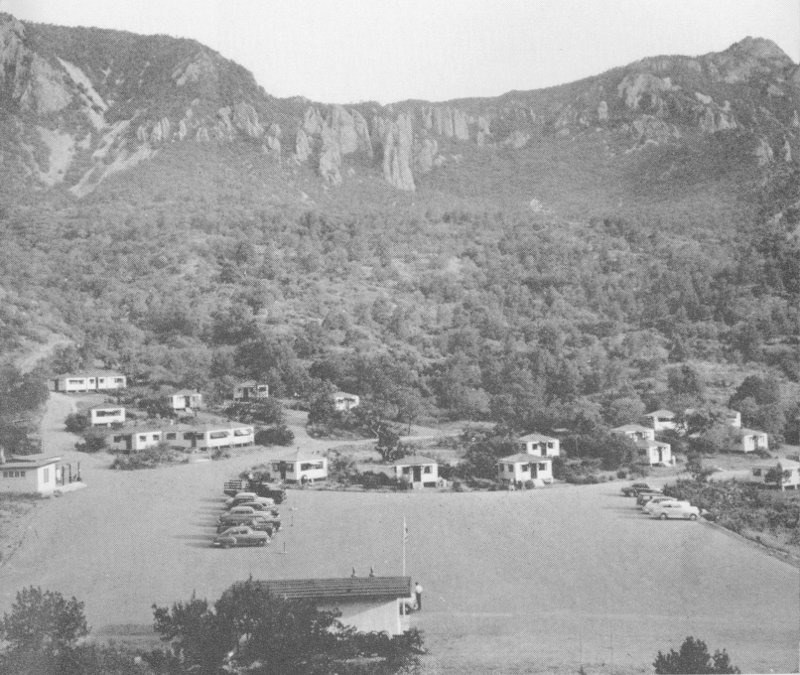
MOUNTAIN COTTAGES IN THE CHISOS BASIN—The Cottages and other accommodations, located at an elevation of 5,400 feet, are completely surrounded by towering mountains. Emory Peak, at the upper right, is the highest in the park.

CHISOS MOUNTAINS COTTAGES AND CASA GRANDE—The Mountain Cottages are located high in the Chisos Basin at an elevation of 5,400 feet above sea level. Casa Grande, towering more than 2,000 feet above the cottages is one of the outstanding mountains of the park.
From a distance of ten miles, the Santa Elena Canyon forms a purple “V” in the Mesa de Anguila and Sierra Ponce. The approach to the canyon becomes more striking with each receding mile, until the sheer cliffs of the yawning gorge rise majestically above the waters of the river. Since it is possible to drive within a few hundred feet of the canyon, this is an ideal trip for all-age groups. Picnic lunches are enjoyable on the sand bars along the Rio Grande or under the shade of the cottonwood trees near the canyon. This spectacular attraction provides an interesting all day outing and scenic trip from the Basin.

THE RIO GRANDE—The Big Bend of the Rio Grande provides the Southern boundary of Big Bend National Park. Within the park boundary, the river courses through three spectacular canyons: Santa Elena, Mariscal and Boquillas.

OAK CREEK CANYON—The trail to the “Window” descends into this chasm where the towering mountain masses dwarf the figures of men.
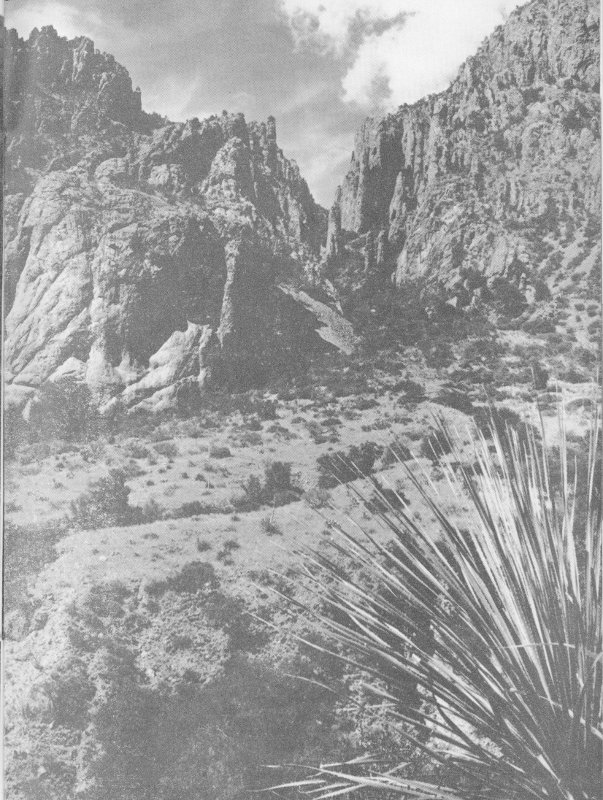
PINNACLES AND CANYONS OF PULLIAM MOUNTAIN—Many unique and interesting rock formations have been created by the erosive action on Pulliam Mountain.

CORRAL—Located in the center of the Chisos Basin, the corral depicts a true western atmosphere. Saddle horses are available for short rides or all day trips into the mountains.
Boquillas, located in the eastern section of the park, is also accessible by automobile. The Rio Grande area retains much of 43 the frontier atmosphere of Texas and Mexico. Farther east near the Boquillas Canyon, Mexico’s Sierra del Carmen Range stands bold and magnificent, one of the most beautiful and inspiring sights of the Park.
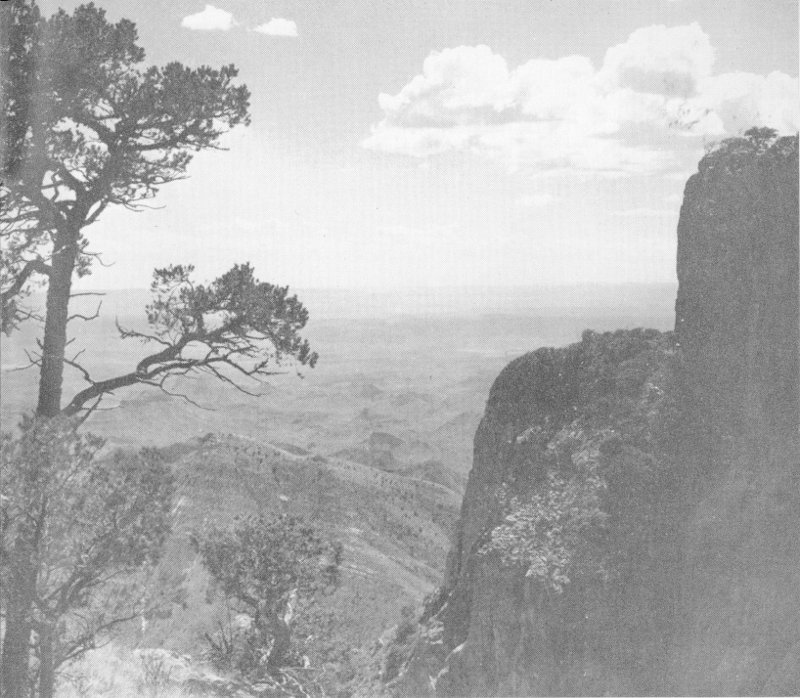
PANORAMA FROM THE SOUTH RIM—Sheer perpendicular cliffs drop more than 1,000 feet from the Rim, sloping into the foothills of the Lower Chisos. Beyond the Rio Grande, in the middle distance, lies the varied terrain of Mexico.
Numerous evening activities provide fun and entertainment for the Park visitor. National Park Service Naturalist and Rangers interpret the natural features and historical background of Big Bend around a campfire circle or in the ranger station.

SANTA ELENA CANYON—Perpendicular walls of the Canyon rise more than 1500 feet above the Rio Grande. Mexico is on the left, the United States on the right.
Far removed from the conventional world, there is a certain friendliness of the Big Bend country that depicts an atmosphere of the old frontier. Devoid of any pretentions, the community high in the Chisos Mountains greets the traveler with the genuine hospitality of the southwest, where informality is the keynote to pleasant living.
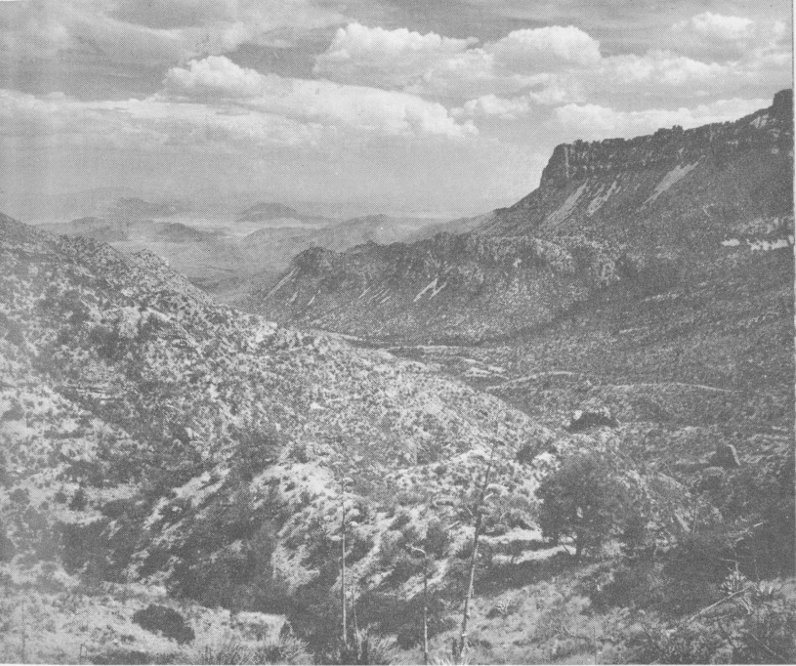
From the Lost Mine Peak Trail ridges and valleys unfold in a striking panorama of mountain scenery.

TRAIL RIDERS AT THE SOUTH RIM—Climaxing the scenery along the South Rim Trail is the spectacular vista from the Rim itself. In the distance, the Sierra del Carmen range is visible in Mexico.
In Big Bend National Park nature rules supreme. Untamed mountains and canyons flaunt a challenge to the adventuresome traveler. Undefiled and unblemished by the annals of time, Big Bend retains its scenic treasures for those who would prospect on the “Last Frontier.”
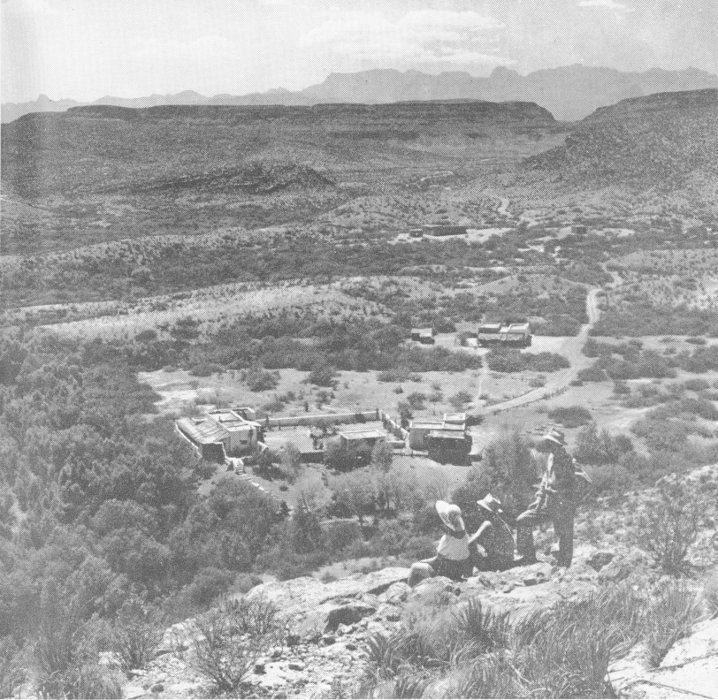
BOQUILLAS RANGER STATION—In the southeastern section of Big Bend National Park, the Boquillas Ranger Station is located near the Rio Grande. The Chisos Mountains form the horizon line in the distance.

CASTELLAN PEAK—Colorful strata reveals various phases of geology in the eroded remnants throughout the Big Bend area.

BIG BEND NATIONAL PARK
TEXAS